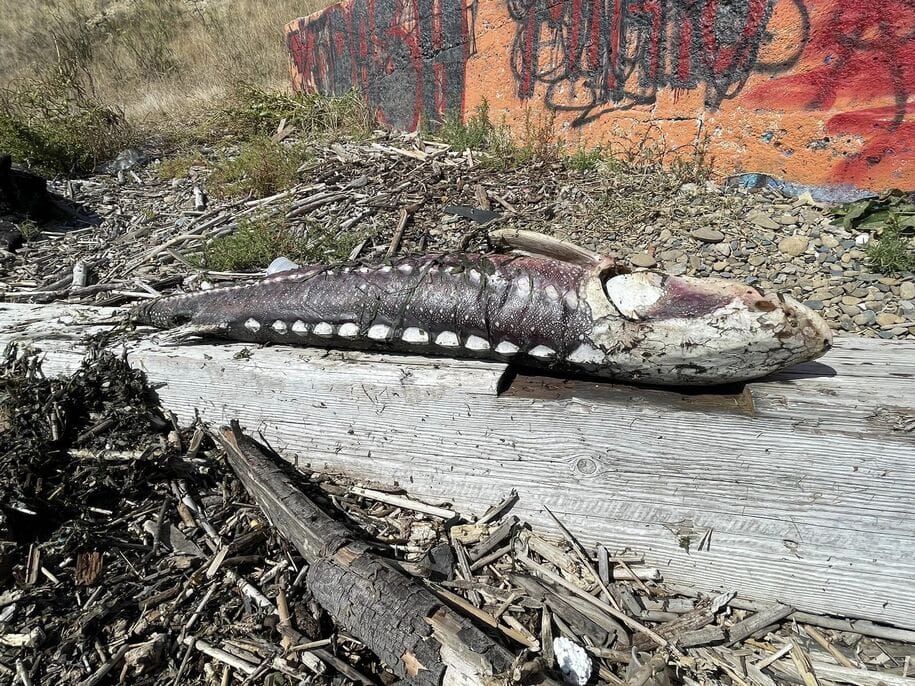Sturgeon perished as algae bloom hit San Francisco Bay and Delta water exports amped up

The first reports of dead white sturgeon, apparently resulting from a red tide algae bloom and oxygen depletion on San Francisco Bay, began to come in on August 4, when five white dead sturgeon off Point Molate were reported by naturalist Damon Tighe in a Facebook post.
Fortunately, Tighe noted on August 8 that the bay’s recent Heterosigma algae bloom “appears to be subsiding.”
“We are still 2 weeks away from the peak bloom during the 2022 event, but it is somewhat comforting to see the recent event not continuing to grow…What is eye opening is how quickly a bloom can take place; in just a matter of 3 days a bloom can grow to impactful levels.”
Last summer, many thousands of fish, including hundreds of white sturgeon and some endangered green sturgeon, perished as a similar bloom spread throughout the bay.
A total of 13 dead white sturgeon have been reported to the inaturalist.org website to date. Seven bat rays, 6 striped bass, 4 Dungeness crab, 2 thornback guitarfish and 2 shovel nose guitarfish have also been reported.
“If you have time, please walk San Francisco bay shore lines, and photograph dead fish,” Tighe urged. “Upload them to iNaturalist and mark them as dead. Those observations will populate this project that CDFW is monitoring.”  https://www.inaturalist.org/…/sf-bay-harmful-algae…
In a press statement issued this week, the California Water Impact Network (C-WIN) also commented on the sturgeon die off, attributing the deaths to oxygen depletion and the red tide toxic algae bloom.
“A similar event occurred last summer, and state officials claim that climate change is the prime mover of both events,” the group stated. “But Tom Cannon, one of California’s most experienced fisheries biologists, maintains the real answers are super moon lunar cycles and a water management policy that prioritizes deliveries over environmental health.”
The group said San Francisco Bay sturgeon need releases from Shasta Reservoir on the Sacramento River to create the cool, clean, brackish conditions in the Bay/Delta estuary essential for their survival.
“It’s ridiculous,” said Cannon, who has consulted extensively for state and federal regulatory agencies. “Unlike 2022, Shasta is now full. The water contractors are getting everything they want and more. Every almond and pomegranate tree in the Central Valley is just sopping with water. There’s enough water for the salmon. Enough for the sturgeon. They’re just not getting it.”
Cannon agreed that climate change is affecting fisheries worldwide, “but what’s happening in San Francisco Bay can be attributed to a specific chain of events and specific policies.”
Cannon observed that super moons are two-week lunar cycles characterized by extreme tides. There are two in August, with the first widely known as the “Sturgeon Moon.”
“Which is both prophetic and dire, given what happened,” Cannon said. “Basically, we had a Delta brimming with slowly-moving water that was nutrient-laden, anoxic [low in oxygen] and very warm – 75° F. The Sturgeon Moon’s neap tide – the minimal tide after the first quarter moon – occurred on July 24th. At that point, the Delta essentially emptied into the Bay. And all that warm water then sat in the Bay for the next two weeks, not moving much, with lots of nutrients and sunshine. And then we see the red tide and the fish dying.”
“The good news is we know how to reduce the nutrient pollution that fuels harmful algal blooms, and many of these solutions have multiple benefits,”
Jon Rosenfeld, PhD.
Last year’s red tide occurred under similar circumstances, but there was a major differentiating factor: 2022 was a drought year, argued Cannon.
“The agencies that control California’s water – the State Department of Water Resources and the U.S. Bureau of Reclamation – could make a legitimate case that there simply wasn’t the water available in the reservoirs to maintain enough flow to keep the rivers and the Delta cool and healthy,” said Cannon. “But 2023 was the opposite. We’re coming off one of the wettest years on record. There’s plenty of water for the rivers, the Delta, and the fish.”
But the agencies apparently don’t see it that way, according to the group. Cannon observed the massive state and federal pumps near Tracy are sending tremendous volumes of water south from the Delta – about 11,000 cubic feet a second, a veritable Colorado River constrained by concrete. Meanwhile, the current volume released for through-Delta flows during the spring tides of the super moons is only about 2,000 cfs.
“It wouldn’t have taken a lot of water to avoid what happened,” Cannon said. “The Lower Sacramento River, which connects to the Delta, is now 75° F. Simply meeting the State Water Resources Control Board’s temperature standard of 68°F for the Lower Sacramento River and Delta would have cooled things down enough to help protect the fish. That would mean releasing an extra 3,000-5,000 cfs from Shasta Dam, which is virtually nothing in terms of the available supply.”
Cannon said the agencies insist they’re “saving” Shasta’s cold water for endangered salmon. But such claims don’t hold up under scrutiny, particularly under current circumstances.
“You can hardly characterize your actions as thrifty when you’re lavishing agricultural contractors with more water than they need,” he said.
“There’s one more supermoon in August and the Delta is heating up again. Cannon notes that water temperatures recently seem to be moderating, though – a sign that the agencies, alarmed by the bad publicity, may be releasing a bit more water in a bid to avoid a disastrous reprise. But that may not matter for the white sturgeon, an iconic species for San Francisco Bay,” according to the group.
“Sturgeon are slow growing and slow to reproduce,” Cannon said. “There were maybe 10,000 sturgeon in the estuary before these events. The total population is certainly a fraction of that now. The Bay’s sturgeon population simply can’t take these kinds of hits and survive. They need more water, and they need it right now.”
Environmental groups and government agencies first revealed that another harmful algae bloom was taking place in sections of the bay this year on Monday, July 31.
San Francisco Baykeeper’s field science team investigated reports to the organization’s pollution hotline and confirmed reddish brown (“tea-colored”) waters in the Berkeley Marina, and subsequently along the shores of Emeryville, Berkeley, and Albany, according to the group.
“We’re carefully monitoring and tracking the bloom because we know the horrible effects that last year’s algae bloom had on marine life,” Eileen White, executive officer of the San Francisco Bay Regional Water Quality Control Board, told reporters in a press conference announcing the bloom.
”We have confirmed with our partners that it’s the same species as last year,” said White, referring to the Heterosigma akashiwo algae.
At the time, White said, “The good news is we have not seen any marine animal deaths as a result of this algae bloom.”
However, that changed with the reports off dead sturgeon and other fish species reported later in the week.
“It’s alarming to see an algae outbreak of this size in the Bay for the second year in a row,” said Baykeeper science director Jon Rosenfield, PhD. “While it’s too early to tell how this harmful algae bloom will proceed, there’s not much that we can do to stop it once it has started. Prevention is the only cure.”
Algae blooms are fueled by elevated levels of nitrogen and phosphorus, also called “nutrient pollution,” said Rosenfield. “San Francisco Bay has some of the highest levels of nutrient pollution of any estuary in the world. This pollution comes primarily from the region’s 37 wastewater treatment plants, which discharge partially treated sewage into the Bay,” he stated.
“The good news is we know how to reduce the nutrient pollution that fuels harmful algal blooms, and many of these solutions have multiple benefits,” Rosenfield added. “We urge the San Francisco Bay Regional Water Quality Control Board to upgrade permits for Bay Area wastewater treatment facilities to dramatically reduce nutrient loads discharged into the Bay, and to encourage nature-based and other multi-benefit solutions.”
Rosenfield said wastewater treatment plants can be modernized to recycle wastewater, reducing nitrogen and phosphorus discharges in the process.
“Building treatment wetlands would capture sewage pollution before it enters the Bay. Restoring the Bay’s historic natural wetlands would absorb excess nitrogen and phosphorus from Bay waters,” he noted.
The Baykeeper said it is investigating this algae bloom and its causes in partnership with the San Francisco Estuary Institute, the U.S. Geological Survey, and other agencies and academic organizations. Baykeeper asks anyone who encounters water that looks or smells suspicious to report it to its pollution hotline.
The latest harmful algae bloom is part of a much bigger problem — the regional, state and federal government water policies that imperil endangered fish in San Francisco Bay, the Delta and Central Valley rivers. In a press conference and rally by Tribes and environmental groups at the State Capitol on July 5, Rosenfield emphasized that the Newsom administration’s water policies “threaten to make California the global leader in fish extinctions.“
“San Francisco Bay’s six endangered fish species demonstrate that the state’s water quality rules are woefully inadequate,” Rosenfield stated. “Repeatedly waiving even inadequate standards has led to the complete closure of California’s salmon fishing season.”
“Despite overwhelming scientific evidence that declining fish populations are driven by unsustainable water diversions, the Newsom administration has taken every opportunity to increase water diversions by powerful corporate agribusinesses and urban water brokers. California must align its water demand with what nature provides, or species that have survived here for millennia will not survive the coming decade,” he concluded.



